Voigtländer Bessa I With Color-Skopar 105mm f3.5 Review
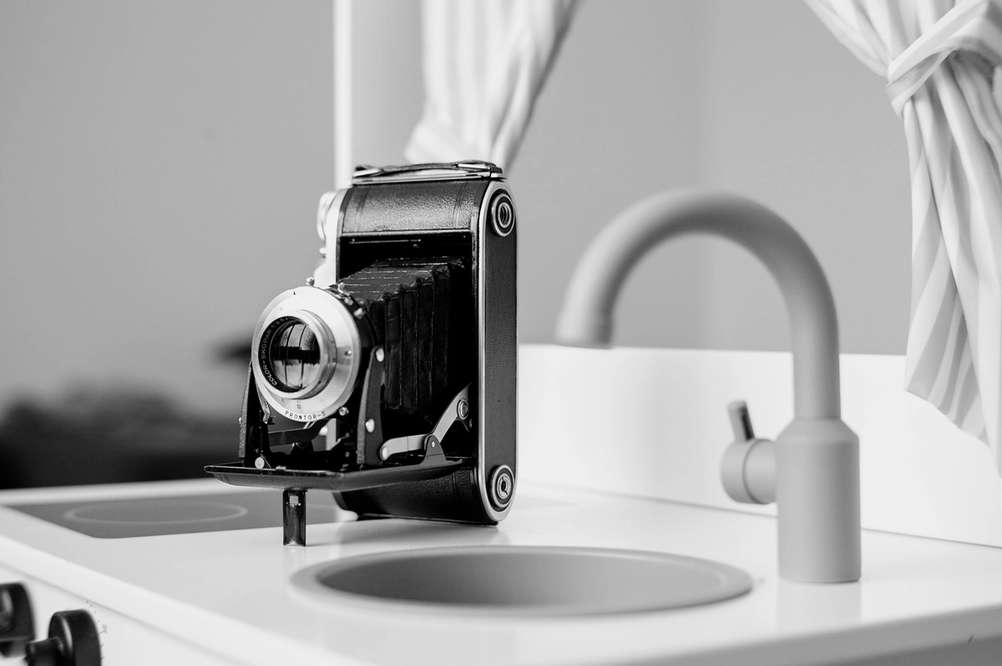
Voigtländer Bessa I. It is quite a good looking camera. Especially when put on top of children's kitchen top.
I already reviewed Voigtländer Bessa I with Vaskar 105mm f4.5 lens and I really, really liked the camera. It's a great 6x9 medium format camera that you can stick in your pocket ( you might need larger than average size pockets ).
The only difference between the Vaskar and Color-Skopar versions is the lens. The lens is almost the same from usability perspective - the difference is in internals and aperture because Vaskar only opens to f4.5 whereas Color-Skopar has a wider f3.5 aperture.
If you wish to read a more in-depth review about the camera in terms of how it is to actually use then please read the Vaskar review as I won't repeat that here. In this review I'll try to show more pictures and focus on the rendering of the Color-Skopar 105mm f3.5 lens. I will also try to compare the rendering with the Vaskar version to try and see whether one is truly superior or not.
I have used this camera in both 6x9 mode and also in 6x4.5 ( more commonly known as 645 ) mode because this camera supports an insert that you can put inside it to make frame size half as big. What's the benefit? More frames on a single 120 roll ( 8 in 6x9 mode and 16 in 645 mode ). And also a slightly different aspect ratio ( 3:2 in 6x9 mode and 4:3 in 645 mode ). I will try to flag which mode is used in each picture.
Thoughts On Lens Rendering

The lens appearance is rendered quite unusual if you're used to rangefinder / SLR lenses. This is quite a normal look for a foldable camera lens.
I already liked the output of the Vaskar lens but Color-Skopar adds some extra magic that pushes it above Vaskar. As it should because it's sold as a better lens.
I will go through some aspects of lens rendering that are important to me. No charts or scientific measurements. I just go by the feel.
Sharpness
You do tend to use closed down apertures ( f8 - f11 ) way more than on other cameras because this is a scale focus camera and you need all the margin of error you can get. In these apertures things will mostly look quite sharp on pretty much all lenses. And it is true for this lens as well. When closed down things are sharp as you would expect.
What about when using a more open aperture? Well it's still sharp! The centre is sharp regardless of aperture. I doubt you would complain about sharpness even if you're used to and prefer modern lens rendering. In 6x9 mode the very corners can get a bit blurry / distorted. It seems to fix itself around f11. But even at wider apertures only the very corners are impacted. It would only bother anyone at super precise landscape or architectural photos where you want sharpness across the whole frame. Otherwise it isn't affecting the image in any negative way.
If you want sharpness across the whole frame sooner - you can shoot in 645 mode. The corners are clear from widest aperture because you're essentially cropping them off with the mask.
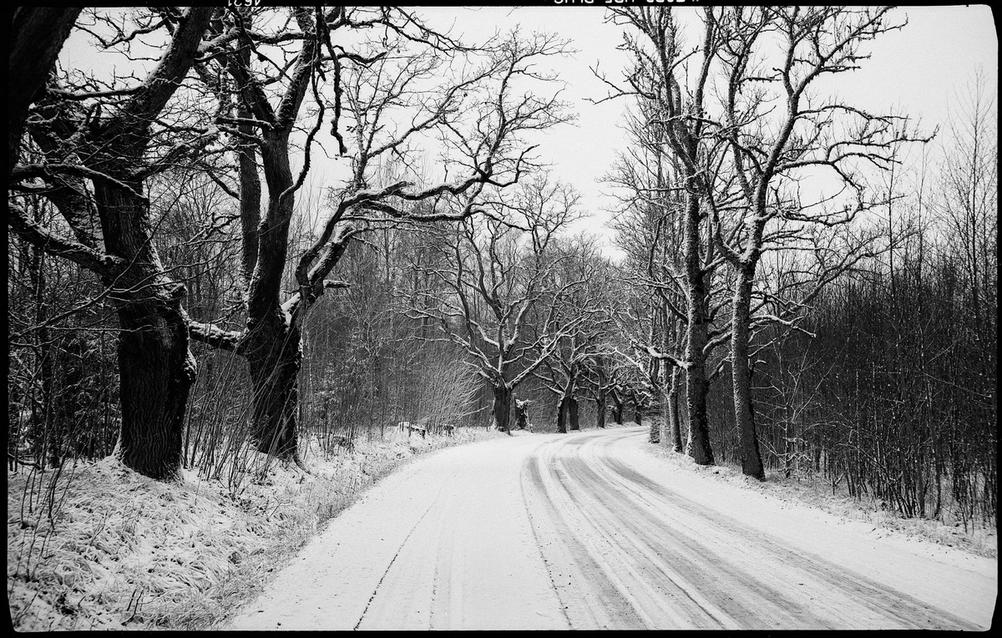
- Camera
- Voigtländer Bessa I
- Lens
- Voigtländer Color-Skopar 105mm f3.5
- Film
- Ilford HP5+ EI3200
- Development
- Kodak HC-110; Dilution A; 9:30min
- Scanner
- Epson V600
An example of sharp and well detailed image. It was at least f8 if not more closed down and using the full 6x9 frame size.
Sharpness is throughout the whole frame. Maybe the very corners are just a tiny bit distorted but unless your printing / scanning with film border - those corners will be cut off anyway to have an even edge.
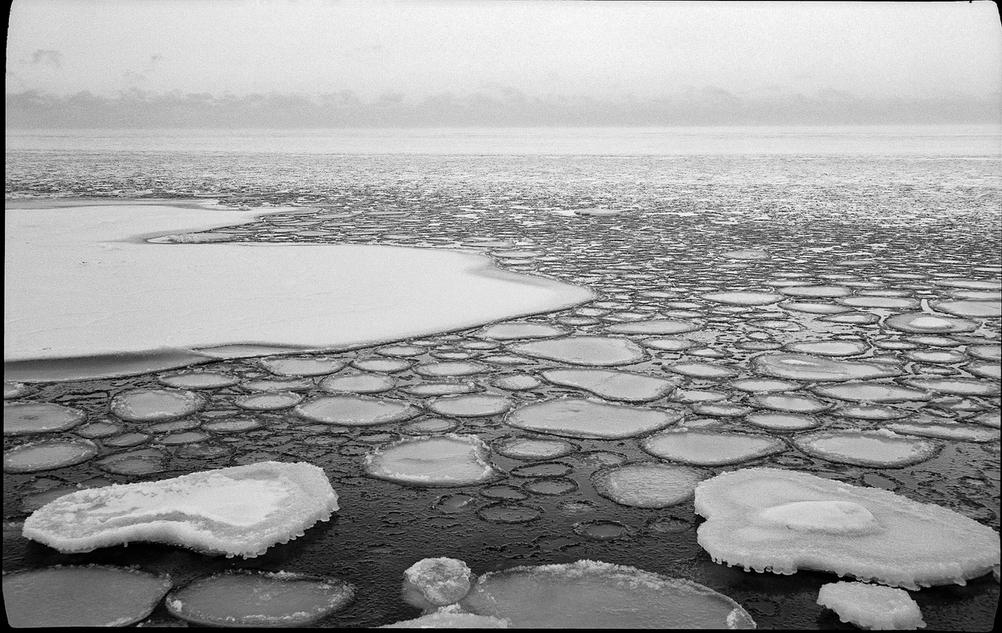
- Camera
- Voigtländer Bessa I
- Lens
- Voigtländer Color-Skopar 105mm f3.5
- Film
- Ilford HP5+ EI3200
- Development
- Kodak HC-110; Dilution A; 9:30min
- Scanner
- Epson V600
Another 6x9 example where there's no corner distortion. 6x9 is an amazing size which can capture a lot of detail.

- Camera
- Voigtländer Bessa I
- Lens
- Voigtländer Color-Skopar 105mm f3.5
- Film
- Bergger Pancro EI400
- Development
- Kodak HC-110; Dilution B; 9:00min
- Scanner
- Epson V600
Here's a 645 shot that shows splendid sharpness with no corner issues. I think this was shot below f8.

- Camera
- Voigtländer Bessa I
- Lens
- Voigtländer Color-Skopar 105mm f3.5
- Film
- Ilford HP5+ EI1600
- Development
- Kodak HC-110; Dilution A; 5:30min
- Scanner
- Epson V600
And one more example in 645 which was shot wide open ( or very close to it ) because the conditions were quite dark.
There's is a bit of motion blur in the shot as even with the high sensitivity and wide aperture the shutter speed was quite slow. It's still solid enough and you can see that the lens can deliver sharp results even at wide apertures ( at least in 645 mode ).
In conclusion. As long as you can guess the distance correctly and set it on the lens - images will come out plenty sharp.
Contrast
Because it's an older lens - you will get an older lens contrast. It means that it won't be super punchy out of the gate. It will have a more mellow contrast and personally I see it as a good thing as it can keep highlights at bay and also allows the shadows to gather more light. Lens is a tad contrastier from around f5.6 and doesn't appear to change in contrast after that.
You shouldn't confuse the not-punchy contrast as a boring looking image or image that's flat. I think that you would only dislike it if you're a super fan of the modern contrasty look. Don't forget that you can always add more contrast in post-processing. Be it digital post-processing or analog. And don't even start with that "photos should not be post-processed" garbage.
You can also easily bump the contrast by pushing the film hard. Or using a more contrasty film stock. No post-processing required.
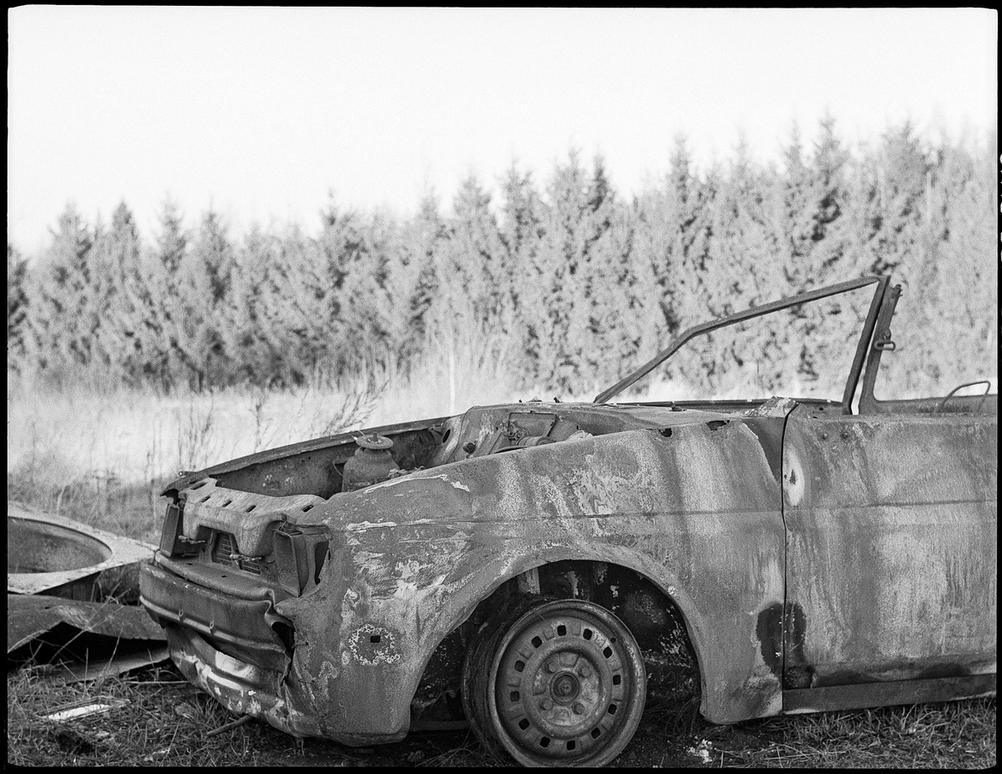
- Camera
- Voigtländer Bessa I
- Lens
- Voigtländer Color-Skopar 105mm f3.5
- Film
- Ilford HP5+ EI1600
- Development
- Kodak HC-110; Dilution A; 5:30min
- Scanner
- Epson V600
I mostly shoot with pushed film when using this camera so contrast on most black and white pictures will be quite high.
Still - this is an example where the lower contrast helped save the scene as the car was in a complete shadow and the trees were in direct sunlight. A more contrasty lens might have struggled with maintaining detail throughout the shadows and highlights.
Shot in 645 mode.

- Camera
- Voigtländer Bessa I
- Lens
- Voigtländer Color-Skopar 105mm f3.5
- Film
- Ilford HP5+ EI1600
- Development
- Kodak HC-110; Dilution A; 5:30min
- Scanner
- Epson V600
This is pushed as well so contrast is still high but maybe not as high as one might expect with plenty of detail around.
Once again in 645 mode.
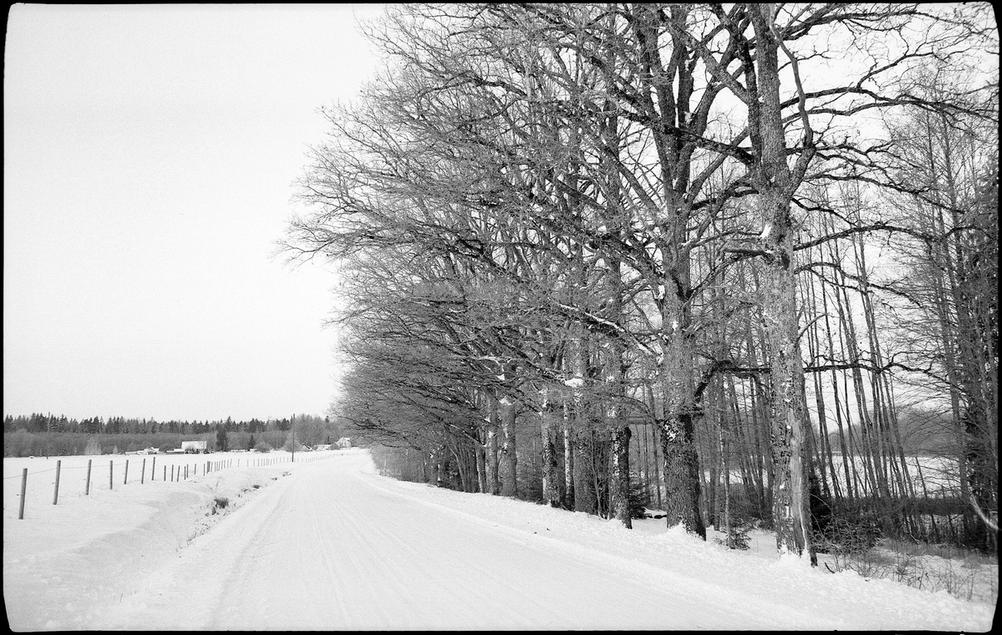
- Camera
- Voigtländer Bessa I
- Lens
- Voigtländer Color-Skopar 105mm f3.5
- Film
- Ilford HP5+ EI3200
- Development
- Kodak HC-110; Dilution A; 9:30min
- Scanner
- Epson V600
Example for 6x9 mode. Pushed hard. But you wouldn't be able to tell that it's pushed from 400 to 3200. Part of it is because of the frame size - medium format film will handle pushing better. Partly is the calmer lens.
In conclusion. Contrast is good for a vintage lens. It's actually very pleasing.
Flare Control
I have not seen this lens flare and I have shot against the sun in quite a few cases. I do try to angle the camera in a way where the side of the bellows holder acts like a small lens hood. I also use my hand as a lens hood. Still - the lens handles flaring very well.
You do see some contrast loss when a super bright sunlight hits the lens just right but it's not terrible. It's actually quite amazing how the lens handles it without any fancy, modern coatings.

- Camera
- Voigtländer Bessa I
- Lens
- Voigtländer Color-Skopar 105mm f3.5
- Film
- Bergger Pancro EI400
- Development
- Kodak HC-110; Dilution B; 9:00min
- Scanner
- Epson V600
The sun is at the very top of this shot and you can see some contrast loss in the middle of this photo. It's quite well controlled - especially for the conditions.
It's not an amazing photo but it's one of the best examples of the worst flaring that you can get. I'm sure it can be worse but not often.
This was in 645 mode.

- Camera
- Voigtländer Bessa I
- Lens
- Voigtländer Color-Skopar 105mm f3.5
- Film
- Lomography Color Negative 100 EI100
- Development
- Tetenal Colortec C-41
- Scanner
- Epson V600
Here's a flaring example in color and 6x9 mode. You can clearly see where the sun is. Yes, it's relatively low so not as bright as it can be but it's still difficult conditions that are once again handled very well.
Slight contrast loss once again and also some fringing in the trees but I do think that some modern lenses would also struggle with these conditions.
In conclusion. Flare control is very, very good.
Color Rendering
Similarly how contrast has a "vintage look" - colors also are rendered in a more "vintage" manner. Colors are more muted but still accurate and I haven't seen them being shifted in weird ways. I like the more muted rendering personally. It's calm and soothing.
From a color balance perspective the lens has a definite warmness. I would even classify it as a darkish yellow with a hint of green. In some aspects it reminds me of Kodak Gold 200 film.
My preference in analog photography is definitely black and white but I would not hesitate shooting color film with this camera / lens. I would only try to avoid it if I'm after a super saturated look ( e.g. Kodak Ektar in autumn or maybe Velvia 50 in sunlight ). But for everyday things and people it's fantastic.
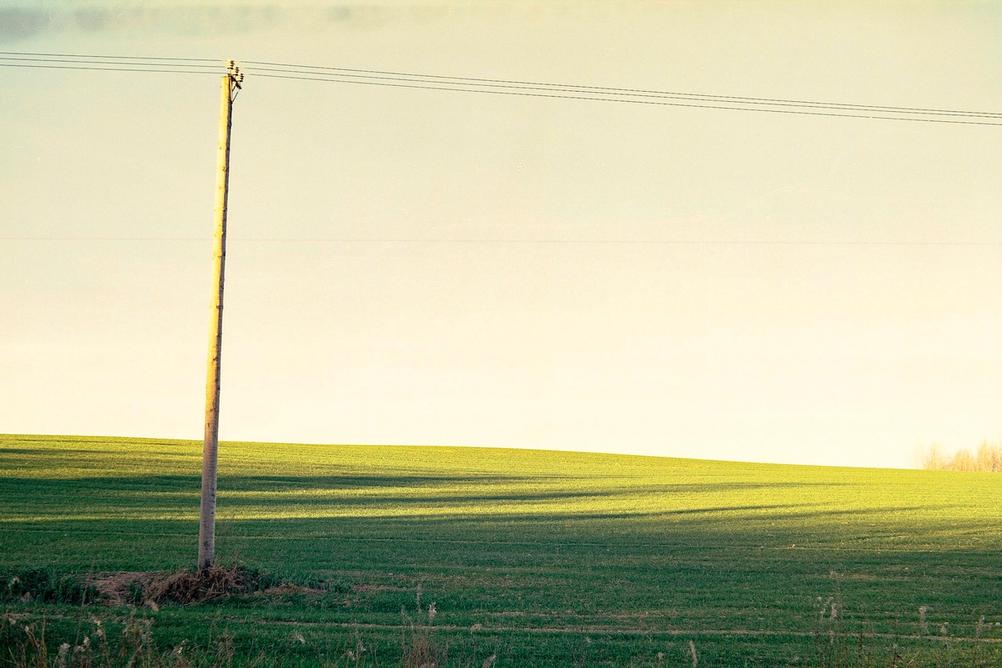
- Camera
- Voigtländer Bessa I
- Lens
- Voigtländer Color-Skopar 105mm f3.5
- Film
- Lomography Color Negative 100 EI100
- Development
- Tetenal Colortec C-41
- Scanner
- Epson V600
A color photo with not too many colors but it perfectly shows the "dirty", "vintage" look. Some of it is film itself but on different cameras I haven't seen the effect so enhanced so I think that part of it is lens itself.

- Camera
- Voigtländer Bessa I
- Lens
- Voigtländer Color-Skopar 105mm f3.5
- Film
- Lomography Color Negative 100 EI100
- Development
- Tetenal Colortec C-41
- Scanner
- Epson V600
A less "vintage" look but shows the muted colors more. The conditions themselves were gray as well.
In conclusion. Colors are warm balanced and are a bit muted which gives them a "vintage" look. I would classify them as calming...and good.
Bokeh And Subject Separation
This is where the lens has some magic. Even though the lens is typically used with closed down apertures - the large frame size means that you can still get some pretty shallow depth of field.
When focussed just right the subject is tack sharp and the transition from sharp to bokeh is very, very amazing. It gives this layered 3D look which the cool kids call 3D-pop. It's one of the best lenses for this - at least from the lenses that I have used. Modern ones included.
Some people have said that Color-Skopar bokeh can be busy looking but to me it is very pleasing. It's smooth without weird edge effects. It blurs just enough to allow you to see what's in the background but still not make it distracting. It also doesn't seem to change the characteristics depending on aperture. Bokeh is largely the same on all of them - it's just that the in-focus area is larger. Only starting at around f22 you lose the ability to blur the background much - at least in 645 mode.
It also seems like it wants to swirl the bokeh. It never truly does it but I can see that it wants to! And I want it as well! Maybe one day I will find this special aperture and subject-to-background distance where some swirly-ness occurs.

- Camera
- Voigtländer Bessa I
- Lens
- Voigtländer Color-Skopar 105mm f3.5
- Film
- Lomography Color Negative 100 EI100
- Development
- Tetenal Colortec C-41
- Scanner
- Epson V600
This is my favourite example of subject separation. My family looks like they are on a completely different layer than the background - in a very pleasing way.
Sure it's not a completely obliterated background but the aperture was quite closed down and also I really like this less bokeh where you can understand what's in the background. But still see the subject separated from it.
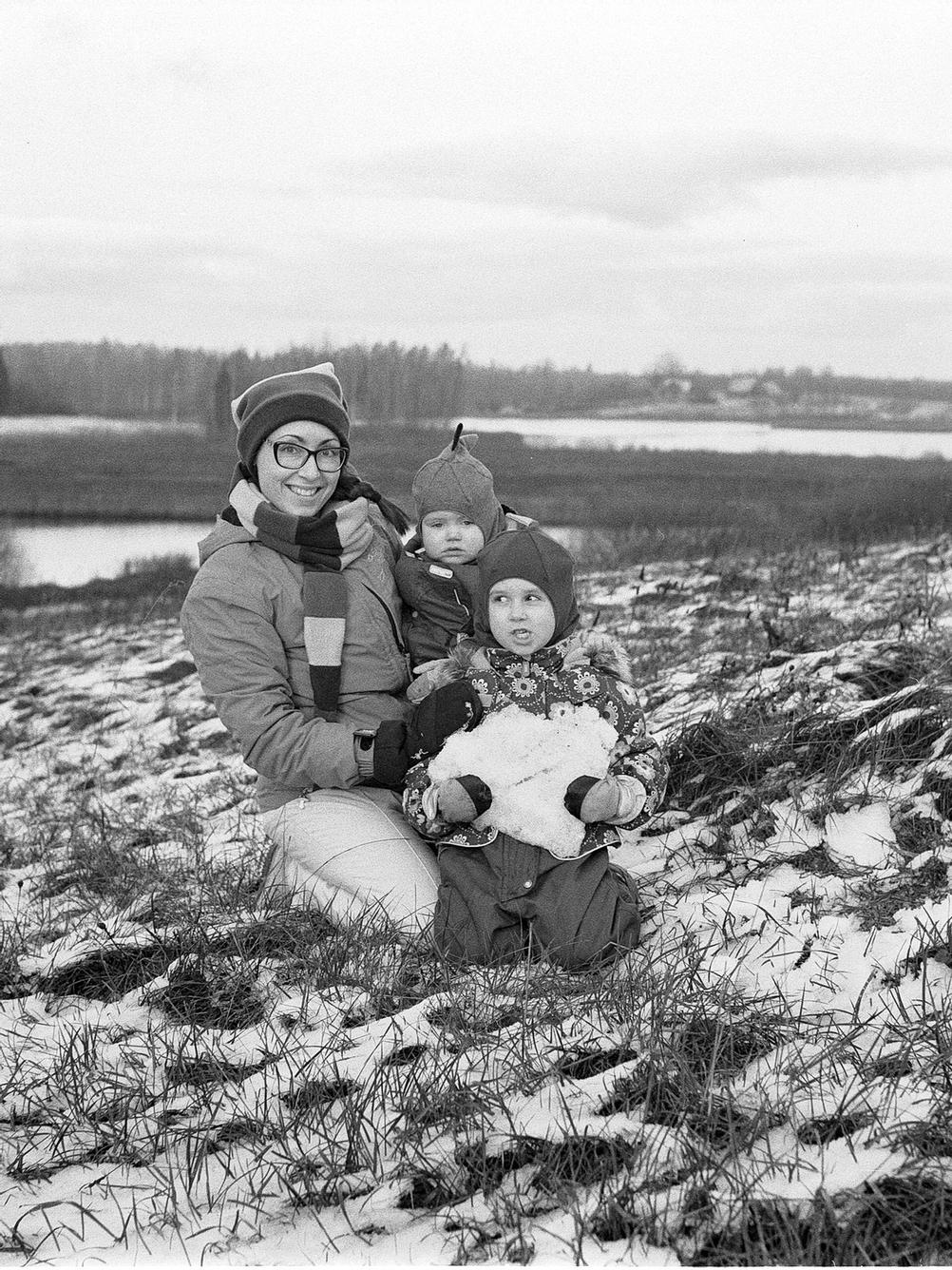
- Camera
- Voigtländer Bessa I
- Lens
- Voigtländer Color-Skopar 105mm f3.5
- Film
- Bergger Pancro EI400
- Development
- Kodak HC-110; Dilution B; 9:00min
- Scanner
- Epson V600
Another example of my background separated family - this time in 645 mode.
The effect is not as pronounced but still very pleasing especially considering the f8 or f11 aperture this was shot in.
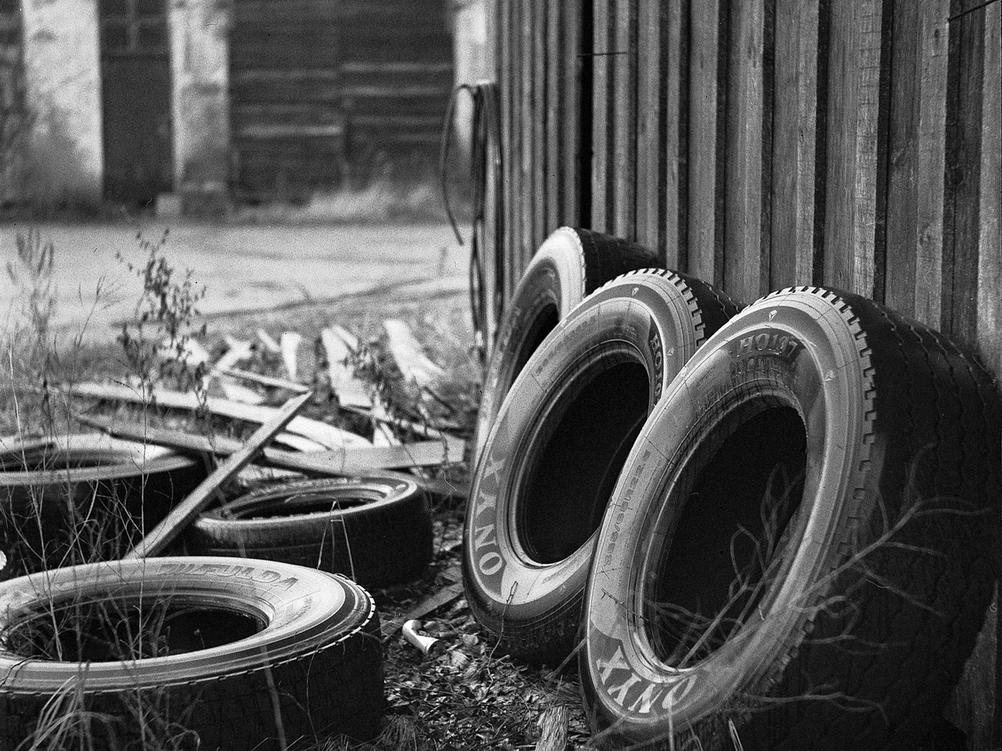
- Camera
- Voigtländer Bessa I
- Lens
- Voigtländer Color-Skopar 105mm f3.5
- Film
- Bergger Pancro EI400
- Development
- Kodak HC-110; Dilution B; 9:00min
- Scanner
- Epson V600
I typically separate my family from the background but when I don't I separate random tyres. This is shot in 645 mode and it has that nice, grungy background blur.
There isn't much subject separation as there is no single subject - more of a slow decline to blurriness.
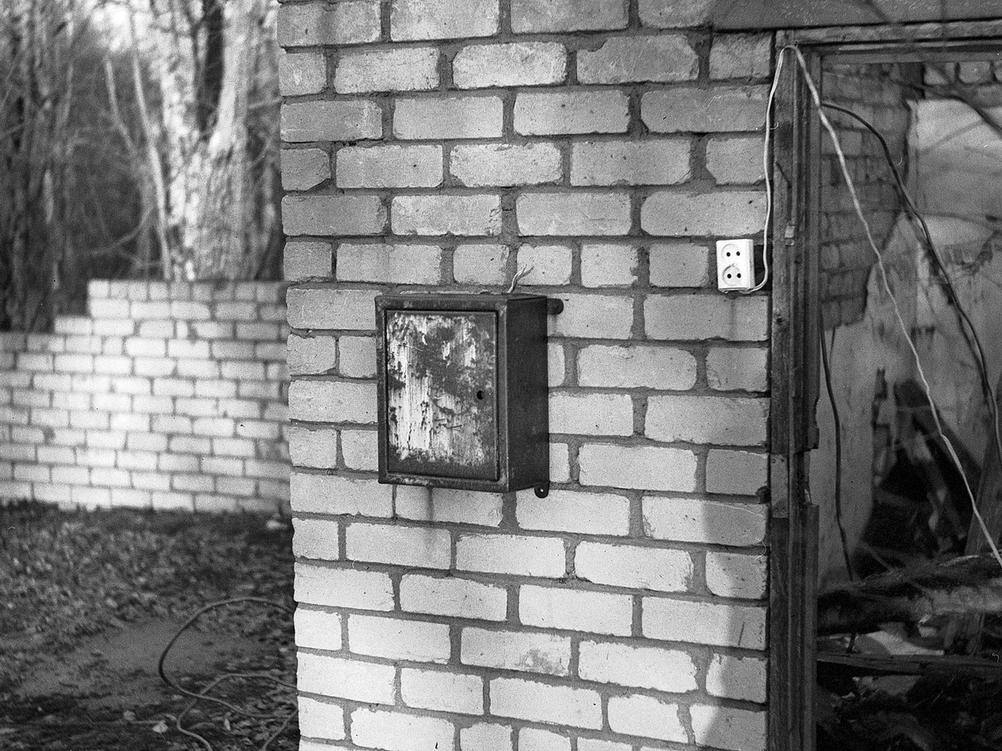
- Camera
- Voigtländer Bessa I
- Lens
- Voigtländer Color-Skopar 105mm f3.5
- Film
- Bergger Pancro EI400
- Development
- Kodak HC-110; Dilution B; 9:00min
- Scanner
- Epson V600
You can't see it but I feel that the background wants to swirl. I swear! Just look at it. A bit of massaging and it will swirl like Helios 44 / Zeiss Biotar.
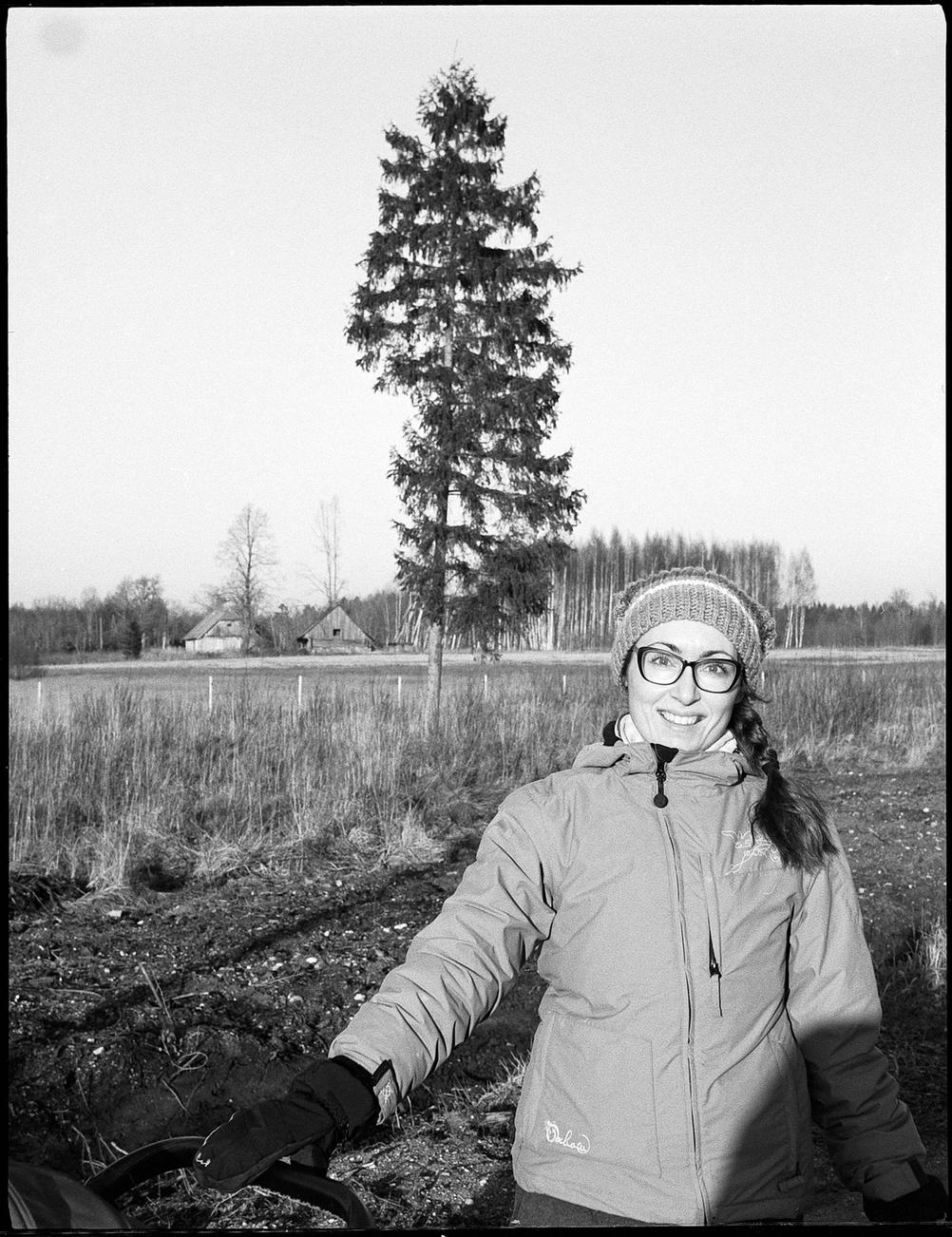
- Camera
- Voigtländer Bessa I
- Lens
- Voigtländer Color-Skopar 105mm f3.5
- Film
- Ilford HP5+ EI1600
- Development
- Kodak HC-110; Dilution A; 5:30min
- Scanner
- Epson V600
And lastly here's a photo with no background blur. This is what happens when you use f22 in 645 mode. Background is slightly blurred but you can only see it when the picture is displayed in a big size.
In conclusion. I'm highly happy with the subject separation and background blur of this lens. It's my favourite feature!
Vaskar V/S Color-Skopar
So what are the differences between Vaskar and Color-Skopar versions?
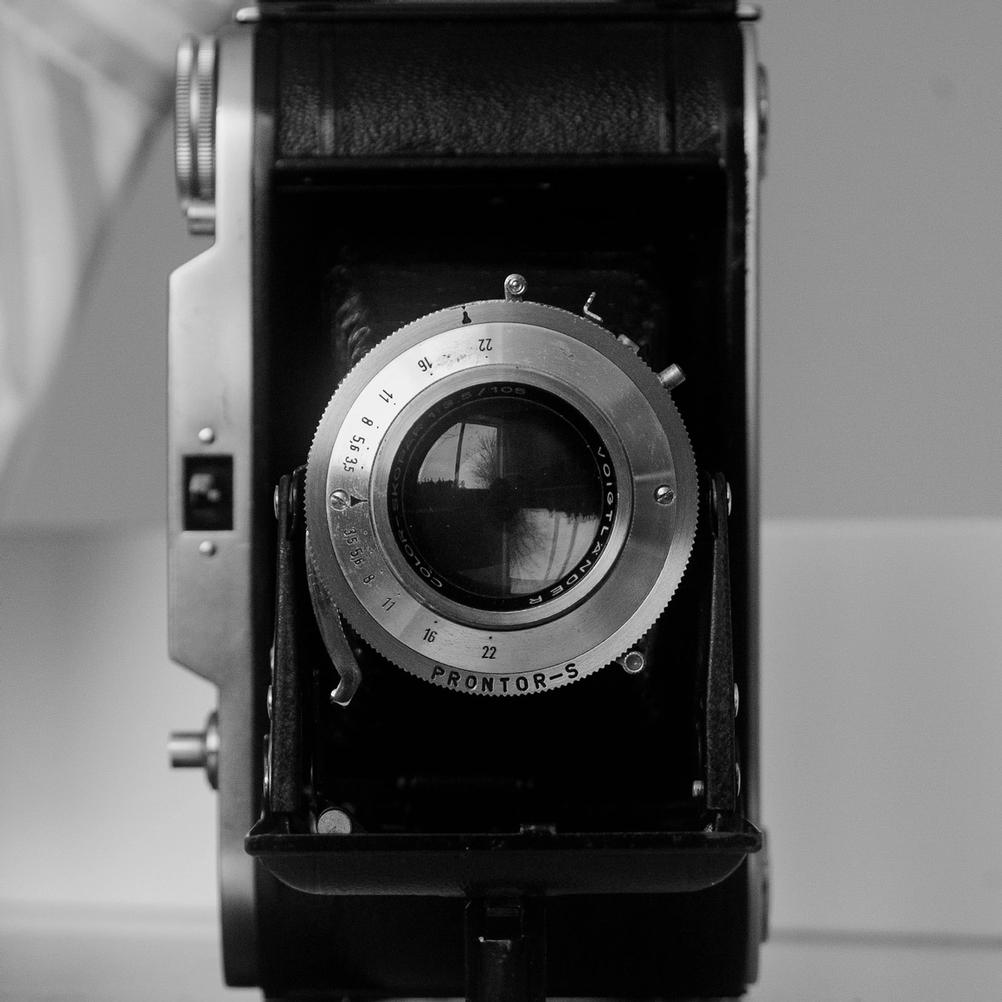
From appearance perspective both lenses look identical. Apart from the writing on them.
Vaskar is typically a more available version and also the cheaper one. Color-Skopar is slightly rarer ( although you shouldn't put "rare" in your Ebay listing ) and has roughly a 10-20% price increase - although prices can vary. The biggest difference is definitely availability as the Vaskar version is easier to acquire.
From a focal length perspective both lenses are identical - 105mm. I have not shot the same thing side by side to see if they are actually identical but I have no reason to doubt this.
Color-Skopar version has a possibility for a wider aperture - f3.5 V/S Vaskar's f4.5. It is a difference but not one that you will use often because of the fact that Bessa I is a scale focussing camera. Focussing on f3.5 ( or even f4.5 ) is difficult unless you focus on infinity or something that's not very close. So whilst on paper f3.5 is better - in reality you won't use this feature much. Unless you have an external rangefinder in which case you could potentially shoot wide open and get reasonable focus.
From a lens design perspective the lenses are different. Vaskar is an older design lens with three elements ( also known as Triplet ) whereas Color-Skopar is a four element Tessar design. "Color" in Color-Skopar also means that it's been tweaked for color accuracy whereas Vaskar hasn't.
Does this matter in real life? Yes and no. Color-Skopar does have a definite edge when shooting anything below f8. Vaskar is more soft with even softer corners and less contrast. But as I said - you don't tend to shoot this camera with open apertures. Around 80% if not more of the shots are at least f8 and typically around f11. At these apertures I don't think there are any differences that should matter unless you're an absolute clinical rendering fan. In which case you shouldn't be shooting these cameras anyway. There's maybe a bit more corner disturbance in Vaskar even when closed down but it's not a big difference. And there's no difference when shooting in 645 mode.
And colors? Even though Color-Skopar is made for color photography I don't think there's a huge color shift / cast with Vaskar. Yes, the colors are a bit more muted but not by a huge margin.
For most people Vaskar should be an acceptable lens to have on Bessa I. That being said, if you have the ability to get a Color-Skopar version - get it. It is a better lens and if you have an external rangefinder or plan to get one - Color-Skopar will have a better rendering than Vaskar when shot with wider apertures. I haven't seen the magical subject separation from Vaskar rendering but I have not shot it wide open as much as Color-Skopar.
In Bessa I the Vaskar was the cheapest lens version. In Bessa II - it was Color-Skopar so it's not like Color-Skopar is leagues ahead of Vaskar. In my opinion all Voigtländer lenses ( at least for the Bessa line ) are very good.
Verdict
That's about all I have to say about Voigtländer Bessa I with Color-Skopar 105mm f3.5 lens. It is the same camera as the Vaskar version so using it is identical. Only the lens is a bit better.
I will be selling the Vaskar version because I don't really need two cameras like Voigtländer Bessa I. I suppose I could use one in 6x9 mode and other in 645 mode but if I do that then I might as well get a dedicated 645 camera that will be even smaller than Bessa I.
Vaskar is the one being sold because Color-Skopar is a better lens. Not by much. But it has that magical subject separation that I really like and I plan to get an external rangefinder to try and shoot this camera more wide open.
So get a Color-Skopar version if you can and the price isn't too high. If you can't? Just get the Vaskar version - it's almost as good.
